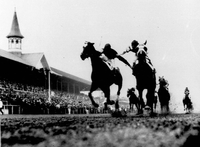|
First: Colt A I think this horse exhibits the most balance and the smoothest topline of the three. He's more upright in his withers and shoulder, which tells me he's going to be able to have more lift in his shoulder and front end. He's cute-headed, with a nice aesthetic overall. His eye is kind, and he looks like he'd be an easy horse to work with.
He has a nice neck that comes out of his shoulder and withers flat and ties in nicely with the shoulder. That tells me that he'll be able to use his neck better for balance and will keep his topline level as he moves. I like the angle to his shoulder--it shows that he'll be able to move with a smooth full stride and should have no problem elevating his shoulders. He's short backed. If you look at the length of his neck, his back and his croup, you'll see they're proportionately similar,which contributes to his balance and the smoothness of his topline. His short back indicates he'll be able to use and round his back athletically. I really like the set of his hocks. If you compare them with the other two horses, his are a little straighter, and that'll help him to reach underneath himself and work off his hindquarters more efficiently. His hocks and knees appear to be more on the same plane, which goes back to a level topline--his hips and withers are level, and so are his knees and hocks. Again, he'll be better able to use his hindquarters and push himself better from behind. I like the length and ample angle of his pasterns. Because I see a nice slope to the pasterns, I know he's not going to have a lot of concussion on his legs and will move smoothly. He's a nice performance prospect, and should do well in Western pleasure or Western riding and other all around pattern events.
Second: Colt B He has a smooth topline and looks good over his croup and back, which tells me most of his angles should be correct. I like how his hip ties in to his gaskin. He looks like he has a little more muscling there than the third-place horse, although he ties into the gaskin lower than the horse I placed first. But his hip looks stronger than the third-place horse. The strength and muscling in his hip and gaskin tell me he should move with good impulsion and use his hindquarters well. He should work well as a reiner or stock-type horse.
Third: Colt C If you look at the angle of his shoulder and pasterns, you'll see they're straighter and don't have the angle the first two horses had. You want to see a little more angle in the pasterns; he's probably going to move with more concussion to his legs on the front end, which makes for a ride that isn't as smooth as the first two horses, and may even put him at increased risk for leg soreness. If you draw an imaginary line from his hocks across his knees, you can see that his hocks are quite a bit higher--which means he'd have a harder time achieving balance and self-carriage. Overall, he lacks the balance of the first two colts, still he appears fairly athletic and should be able to make a nice performance horse. Steve Heckaman is a National Snaffle Bit Association past president, who was inducted into the organization's hall of fame in 2001. He's at the top of his game in Western pleasure and has won 13 All American Quarter Horse Congress Western pleasure championships, including the Western pleasure maturity with his stallion, Potential Investment, in 1996. He stands the stallion at his facility in Aubrey, Texas. This Conformation Clinic originally appeared in the January 2006 issue of Horse & Rider magazine. Enter Your Horse in Conformation Clinic! If you'd like to enter your horse in Conformation Clinic send Horse & Rider a left-side view photo of him (make sure he's well groomed, looking straight ahead and standing on level ground--and try to avoid distracting backgrounds). Include your contact info, the "discipline" you participate in with your horse (or hope to) and your horse's breed, age, gender and height. Send the photo and information to: Horse & Rider, 2000 S. Stemmons Freeway, Suite 101, Lake Dallas, TX 75065, or send an email to alana.harrison@equinetwork.com. |
| Find this article at: http://www.equisearch.com/horses_care/health/anatomy/yearlingconformation_122805/index1.aspx |
Trackback URL : 이 글에는 트랙백을 보낼 수 없습니다
Trackback RSS : http://www.fallight.com/rss/trackback/1343
Trackback ATOM : http://www.fallight.com/atom/trackback/1343











